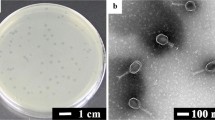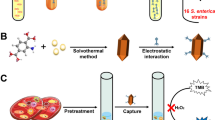Abstract
The development of a novel colorimetric method is reported, using vB_YepM_ZN18 phages along with AuPt nanozyme for the sensitive detection of Y. pseudotuberculosis. The phage used in this work has been extracted from hospital sewer water and is highly specific toward Y. pseudotuberculosis. The synthesized AuPt NPs possess peroxidase-like activity, which is suitable in the development of nanozyme based detection system. Furthermore, phages@MB and AuPt@phages are added into the bacterial samples for co-incubation, forming an intercalated complex. The magnetic separation and absorbance analysis of enzymatic reaction are carried out for the detection of targeted bacteria. The proposed method has a limit of detection of 14 CFU/mL, a wide linear range from 2.50 × 101 ~ 2.50 × 107 CFU/mL and the assay completion time is 40 min. Benefitting from the outperformance of this sensor, we have successfully employed the developed sensing platform for the detection of Y. pseudotuberculosis in food industry and hospital specimens.
Graphical Abstract






Similar content being viewed by others
References
Bonardi S, Bruini I, D’incau M, Van Damme I, Carniel E, Brémont S, Cavallini P, Tagliabue S, Brindani F (2016) Detection, seroprevalence and antimicrobial resistance of Yersinia enterocolitica and Yersinia pseudotuberculosis in pig tonsils in Northern Italy. Int J Food Microbiol 235:125–132
Lee YJ, Kim J, Jeon JH, Seok H, Choi WS, Chang E-A, Yim HJ, Park DW (2021) Extraintestinal manifestation of Yersinia pseudotuberculosis bacteremia as acute hepatitis: case report and review of the literature. Pathogens 10(10):1255
Sundin C, Zetterström CE, Vo DD, Brkljača R, Urban S, Elofsson M (2020) Exploring resveratrol dimers as virulence blocking agents–attenuation of type III secretion in Yersinia pseudotuberculosis and Pseudomonas aeruginosa. Sci Rep 10(1):1–11
Bliska JB, Brodsky IE, Mecsas J (2021) Role of the Yersinia pseudotuberculosis virulence plasmid in pathogen-phagocyte interactions in mesenteric lymph nodes. EcoSal Plus 9(2):eESP-0014–2021
Wielkoszynski T, Moghaddam A, Bäckman A, Broden J, Piotrowski R, Mond-Paszek R, Kozarenko A, Ny T, Wilczynska M (2018) Novel diagnostic ELISA test for discrimination between infections with Yersinia enterocolitica and Yersinia pseudotuberculosis. Eur J Clin Microbiol Infect Dis 37(12):2301–2306
Iwata K, Morishita N, Masuda Y, Kodama M, Otani S, Naito A (2020) Unilateral inguinal lymphadenitis caused by Yersinia pseudotuberculosis. A case report. J Infect Chemother 26(7):762–764
Farooq U, Yang Q, Ullah MW, Wang S (2018) Bacterial biosensing: recent advances in phage-based bioassays and biosensors. Biosens Bioelectron 118:204–216
Asif M, Xu Y, Xiao F, Sun Y (2021) Diagnosis of COVID-19, vitality of emerging technologies and preventive measures. Chem Eng J 423:130189. https://doi.org/10.1016/j.cej.2021.130189
Aziz A, Asif M, Ashraf G, Iftikhar T, Hu J, Xiao F, Wang S (2022) Boosting electrocatalytic activity of carbon fiber@fusiform-like copper-nickel LDHs: sensing of nitrate as biomarker for NOB detection. J Hazard Mater 422:126907. https://doi.org/10.1016/j.jhazmat.2021.126907
Asif M, Ashraf G, Aziz A, Iftikhar T, Wang Z, Xiao F, Sun Y (2022) Tuning the Redox chemistry of copper oxide nanoarchitectures integrated with rGOP via facet engineering: sensing H2S toward SRB detection. ACS Appl Mater Interfaces 14(17):19480–19490. https://doi.org/10.1021/acsami.2c02119
Janczuk M, Niedziółka-Jönsson J, Szot-Karpińska K (2016) Bacteriophages in electrochemistry: a review. J Electroanal Chem 779:207–219. https://doi.org/10.1016/j.jelechem.2016.05.019
Asif M, Aziz A, Wang Z, Ashraf G, Wang J, Luo H, Chen X, Xiao F, Liu H (2019) Hierarchical CNTs@CuMn layered double hydroxide nanohybrid with enhanced electrochemical performance in H2S detection from live cells. Anal Chem 91(6):3912–3920. https://doi.org/10.1021/acs.analchem.8b04685
Hussain W, Ullah MW, Farooq U, Aziz A, S Wang (2021) Bacteriophage-based advanced bacterial detection: concept, mechanisms, and applications. Biosens Bioelectron 112973
Aslan H, Ekinci A, Aslan I (2020) Nucleic acid–based methods in the detection of foodborne pathogens, natural remedies for pest, disease and weed control, Elsevier pp. 143–161
Pang B, Zhao C, Li L, Song X, Xu K, Wang J, Liu Y, Fu K, Bao H, Song D (2018) Development of a low-cost paper-based ELISA method for rapid Escherichia coli O157: H7 detection. Anal Biochem 542:58–62
Wu Y, Wu M, Liu C, Tian Y, Fang S, Yang H, Li B, Liu Q (2021) Colloidal gold immunochromatographic test strips for broad-spectrum detection of Salmonella. Food Control 126:108052
Petsios S, Fredriksson-Ahomaa M, Sakkas H, Papadopoulou C (2016) Conventional and molecular methods used in the detection and subtyping of Yersinia enterocolitica in food. Int J Food Microbiol 237:55–72
Richter Ł, Bielec K, Leśniewski A, Łoś M, Paczesny J, Hołyst R (2017) Dense layer of bacteriophages ordered in alternating electric field and immobilized by surface chemical modification as sensing element for bacteria detection. ACS Appl Mater Interfaces 9(23):19622–19629. https://doi.org/10.1021/acsami.7b03497
Justino CIL, Duarte AC, Rocha-Santos TAP (2016) Critical overview on the application of sensors and biosensors for clinical analysis. TrAC, Trends Anal Chem 85:36–60. https://doi.org/10.1016/j.trac.2016.04.004
Rippa M, Castagna R, Pannico M, Musto P, Borriello G, Paradiso R, Galiero G, BollettiCensi S, Zhou J, Zyss J (2017) Octupolar metastructures for a highly sensitive, rapid, and reproducible phage-based detection of bacterial pathogens by surface-enhanced Raman scattering. ACS Sensors 2(7):947–954
Wu L, Song Y, Luan T, Ma L, Su L, Wang S, Yan X (2016) Specific detection of live Escherichia coli O157:H7 using tetracysteine-tagged PP01 bacteriophage. Biosens Bioelectron 86:102–108. https://doi.org/10.1016/j.bios.2016.06.041
Niyomdecha S, Limbut W, Numnuam A, Kanatharana P, Charlermroj R, Karoonuthaisiri N, Thavarungkul P (2018) Phage-based capacitive biosensor for Salmonella detection. Talanta 188:658–664
Wang X-Y, Yang J-Y, Wang Y-T, Zhang H-C, Chen M-L, Yang T, Wang J-H (2021) M13 phage-based nanoprobe for sers detection and inactivation of staphylococcus aureus. Talanta 221:121668
Liang Q, Xi J, Gao XJ, Zhang R, Yang Y, Gao X, Yan X, Gao L, Fan K (2020) A metal-free nanozyme-activated prodrug strategy for targeted tumor catalytic therapy. Nano Today 35:100935
Jiang D, Ni D, Rosenkrans ZT, Huang P, Yan X, Cai W (2019) Nanozyme: new horizons for responsive biomedical applications. Chem Soc Rev 48(14):3683–3704
Wang X, Wei H (2020) Peroxidase-like nanozyme sensing arrays for versatile analytes. J Nanopart Res 22(1):22. https://doi.org/10.1007/s11051-019-4738-4
Han J, Yoon J (2020) Supramolecular nanozyme-based cancer catalytic therapy. ACS Appl Bio Mater 3(11):7344–7351
Song W, Zhao B, Wang C, Ozaki Y, Lu X (2019) Functional nanomaterials with unique enzyme-like characteristics for sensing applications. J Mater Chem B 7(6):850–875
Lin Z, Zhang X, Liu S, Zheng L, Bu Y, Deng H, Chen R, Peng H, Lin X, Chen W (2020) Colorimetric acid phosphatase sensor based on MoO3 nanozyme. Anal Chim Acta 1105:162–168
Cai S, Yang R (2020) Noble Metal-Based Nanozymes. Springer, Nanozymology, pp 331–365
Liu Q, Zhang A, Wang R, Zhang Q, Cui D (2021) A review on metal-and metal oxide-based nanozymes: properties, mechanisms, and applications. Nano-Micro Letters 13(1):1–53
Lu C, Tang L, Gao F, Li Y, Liu J, Zheng J (2021) DNA-encoded bimetallic Au-Pt dumbbell nanozyme for high-performance detection and eradication of Escherichia coli O157:H7. Biosens Bioelectron 187:113327. https://doi.org/10.1016/j.bios.2021.113327
Pietrzak M, Ivanova P (2021) Bimetallic and multimetallic nanoparticles as nanozymes. Sens Actuators, B Chem 336:129736
Sambrook J, Fritsch EF, Maniatis T (1989) Molecular cloning: a laboratory manual, Cold spring harbor laboratory press
Funding
This work was supported by the National Key Research and Development Program of China under Grant 2017YFC1104402 and 2022T150232 and China Postdoctoral Science Foundation (2022T150232).
Author information
Authors and Affiliations
Corresponding authors
Ethics declarations
Conflict of interest
The authors have no conflict of interest.
Additional information
Publisher's note
Springer Nature remains neutral with regard to jurisdictional claims in published maps and institutional affiliations.
Supplementary Information
Below is the link to the electronic supplementary material.
Rights and permissions
Springer Nature or its licensor (e.g. a society or other partner) holds exclusive rights to this article under a publishing agreement with the author(s) or other rightsholder(s); author self-archiving of the accepted manuscript version of this article is solely governed by the terms of such publishing agreement and applicable law.
About this article
Cite this article
Yang, Q., Wu, D., Aziz, A. et al. Colorimetric platform based on synergistic effect between bacteriophage and AuPt nanozyme for determination of Yersinia pseudotuberculosis. Microchim Acta 190, 76 (2023). https://doi.org/10.1007/s00604-023-05643-z
Received:
Accepted:
Published:
DOI: https://doi.org/10.1007/s00604-023-05643-z




